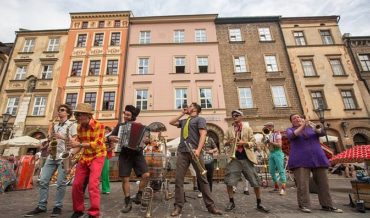Contents
Key Facts
- French literary giant born in Tours (1799) and died in Paris (1850)
- Visited Krakow four times between 1847-1850 while traveling to see his future wife in Ukraine
- Called Krakow "the corpse of the capital" despite being impressed by Wawel Cathedral
- Actually stayed at Hotel pod Białą Różą on Stradom Street, not the famous Hotel Pod Różą
- Memorial plaque controversy lasted until 1974 when historian Dr Michał Rożek revealed the truth
- Works popularized in Poland through translations by Tadeusz Boy-Żeleński
The Literary Master and His Polish Connection
Honoré de Balzac was a French writer whose works have achieved worldwide recognition and continue to captivate readers across the globe. Born in Tours in 1799 and passing away in Paris in 1850, Balzac left behind an extraordinary literary legacy that includes his monumental work "La Comédie Humaine" (The Human Comedy), a sweeping panorama of French society comprising 91 novels and short stories.
His works gained particular popularity in Poland, largely thanks to the remarkable translations made by Tadeusz Boy-Żeleński, a prominent Polish writer, physician, and translator who masterfully rendered Balzac's complex prose into Polish. Boy-Żeleński's genius lay in his ability to transpose not only the literal meaning but also Balzac's intricate social observations, nuanced psychological portraits, and unique stylistic flair into a Polish idiom that felt entirely natural yet faithful to the original. His extensive vocabulary, literary sensitivity, and profound understanding of both French and Polish cultures allowed him to bridge the linguistic and cultural gaps, making Balzac's complex narratives accessible and beloved to a broad Polish readership.
Balzac's Journeys Through Krakow
The Romance Behind the Travels
Balzac's connection to Krakow stemmed from his passionate love affair with Countess Ewelina Hańska, a wealthy Polish aristocrat whom he had been courting through correspondence for years. While traveling to Ukraine to visit his future wife, Balzac stopped in Krakow on four separate occasions, each visit adding another chapter to his complex relationship with the ancient Polish city.
First Impressions: September 1847
For the first time, this significant visit occurred on September 9-10th, 1847. During this brief but memorable stay, Balzac managed to explore the magnificent Wawel Castle hill, where he was particularly amazed by the stunning Wawel Cathedral with its Renaissance chapels and royal tombs. The cathedral's architectural splendor and historical significance clearly left a profound impression on the French master of realism.
However, the city itself didn't impress him at all. In his characteristic blunt manner, Balzac even went so far as to call Krakow "the corpse of the capital" – a harsh judgment that reflected the city's diminished political status following the partitions of Poland and the transfer of the capital to Warsaw.
The Historical Context of "Corpse of the Capital"
This harsh assessment reflected the profound impact of the Partitions of Poland (1772-1795), which had stripped Krakow of its centuries-old role as the nation's capital. The partitions led to the dissolution of the Polish-Lithuanian Commonwealth, with Krakow initially becoming part of the Austrian Empire. Following the Congress of Vienna in 1815, the city briefly gained autonomy as the Free City of Krakow under the joint protection of Austria, Russia, and Prussia. However, after the failed 1846 uprising, this independence ended when Austria incorporated the city into Galicia.
By 1847, when Balzac first visited, Krakow found itself under foreign rule, struggling economically and politically – a stark contrast to its former glory as a royal capital. The city's population had declined, many historic buildings were in disrepair, and the vibrant cultural life that once characterized the royal capital had significantly diminished. This decline, juxtaposed with the vibrant capital of his own France, likely informed Balzac's bleak assessment of what he perceived as a city living in the shadow of its glorious past.
Subsequent Visits: A Pattern of Transit
His next two visits to Krakow took place in February and September 1848, during a particularly turbulent period in European history marked by revolutionary movements across the continent, including the Spring of Nations that swept through Austria-Hungary. These were brief stopovers, as Balzac was primarily focused on reaching his beloved Ewelina in Ukraine.
The final visit occurred on May 4th, 1850, just months before Balzac's death. By this time, he had finally married Countess Hańska in March 1850, but his health was rapidly deteriorating due to years of excessive coffee consumption, poor diet, and relentless work schedules. The local newspaper "Czas" (Time) even published an article about him and his wife staying in the city, documenting the presence of the famous French author and reflecting the cultural interest his visits generated among Krakow's intellectual circles.
The Hotel Mystery: A Tale of Two Roses
The Commemorative Plaque
In 1967, the Polish Society of Cooperation with France decided to honor Balzac's connection to Krakow by hanging a memorial plaque on the wall of the prestigious Hotel "Pod Różą" (Under the Rose) located at Floriańska Street 14. The plaque solemnly declared: "Balzac was staying here on the 4th-5th of May 1850", creating what would become a cherished piece of local literary lore.
The Historical Truth Revealed
However, this well-intentioned commemoration was based on a historical misconception. The fact is that Balzac was actually staying in a different establishment with a confusingly similar name: Hotel pod Białą Różą (Under the White Rose), located at Stradom Street 13. This hotel was situated in the historic Stradom district, closer to Wawel Castle and in a different part of the city entirely.
The Evolution of Hotel Names
The confusion arose from the complex history of Krakow's hospitality establishments. The hotel at Floriańska Street had a completely different name in 1850 – it was called "Ruski" (Russian) to commemorate the visit of Russian Tsar Alexander I and Prince Konstantin during the period when Krakow was under Austrian rule within the Free City of Krakow.
After the failure of the 1863 January Uprising, anti-Russian sentiment made the name politically problematic, so the hotel's name was changed. The establishment was renamed after a restaurant "Pod Białą Różą" that was relocated from Stradomska Street to Floriańska Street in 1853. Over time, the word "Białą" (White) was gradually dropped from common usage, and that's how the simplified name "Pod Różą" was eventually created.
Dr. Michał Rożek's Definitive Research
The myth about Balzac's stay in the hotel on Floriańska Street persisted for decades until 1974, when Dr Michał Rożek, a distinguished Polish historian specializing in Krakow's history, conducted exhaustive archival research and published a groundbreaking article revealing the true story. His findings were published in "Rocznik Krakowski" (Krakow Yearbook), Volume 45 (1974), a prestigious academic publication dedicated to the city's history and culture.
Dr. Rożek's meticulous research involved a comprehensive cross-referencing of diverse primary sources. He systematically examined original hotel registers and guest records from the 1850s, which provided direct evidence of guest stays. He scrutinized contemporary Krakow newspaper accounts, particularly "Czas," and official travel documents for any mention of Balzac's visits. Furthermore, his analysis extended to city directories and commercial listings of the era, which shed light on the exact locations and names of hospitality establishments, alongside a thorough investigation into the architectural and naming histories of both the Hotel Pod Różą and the Hotel pod Białą Różą, unraveling the complex evolution of their identities over decades of political and social change.
This rigorous historical methodology, involving multiple independent sources and careful chronological analysis, definitively established the true location of Balzac's accommodation and demonstrated the importance of primary source verification in historical research.
Legacy and Cultural Impact
Balzac's Lasting Influence in Poland
Despite his dismissive comments about Krakow, Balzac's literary influence in Poland has been profound and enduring. His realistic portrayal of society, complex character development, and detailed social commentary resonated strongly with Polish readers who recognized similar themes in their own national literature, particularly during periods of social transformation and political upheaval.
The Boy-Żeleński translations remain classics of Polish literature, and Balzac's works continue to be widely read, studied in schools and universities, and adapted for Polish theater and television. His influence can be traced in the works of later Polish realist writers who adopted his techniques of social observation and character analysis, contributing to the development of Polish literary realism.
The Importance of Historical Accuracy
The story of the misplaced memorial plaque serves as a valuable lesson about the importance of rigorous historical research and the dangers of perpetuating well-intentioned but inaccurate local legends. Dr. Rożek's work exemplifies the crucial role that dedicated historians play in preserving authentic historical memory and correcting popular misconceptions through systematic archival investigation.
This case study demonstrates how historical myths can develop and persist for decades, even when supported by official commemorations, until subjected to thorough scholarly scrutiny. It underscores the need for primary source verification and the application of rigorous historical methodology in establishing factual accuracy.
Today, visitors to Krakow can appreciate both the literary connection to Balzac and the fascinating story of how historical myths develop and are eventually corrected through scholarly investigation. The tale adds another layer to Krakow's rich tapestry of cultural and literary associations, demonstrating how even brief visits by prominent figures can create lasting connections between cities and international culture, particularly in the atmospheric Old Town where both hotels were located, while also highlighting the ongoing importance of historical research in preserving authentic cultural memory.

